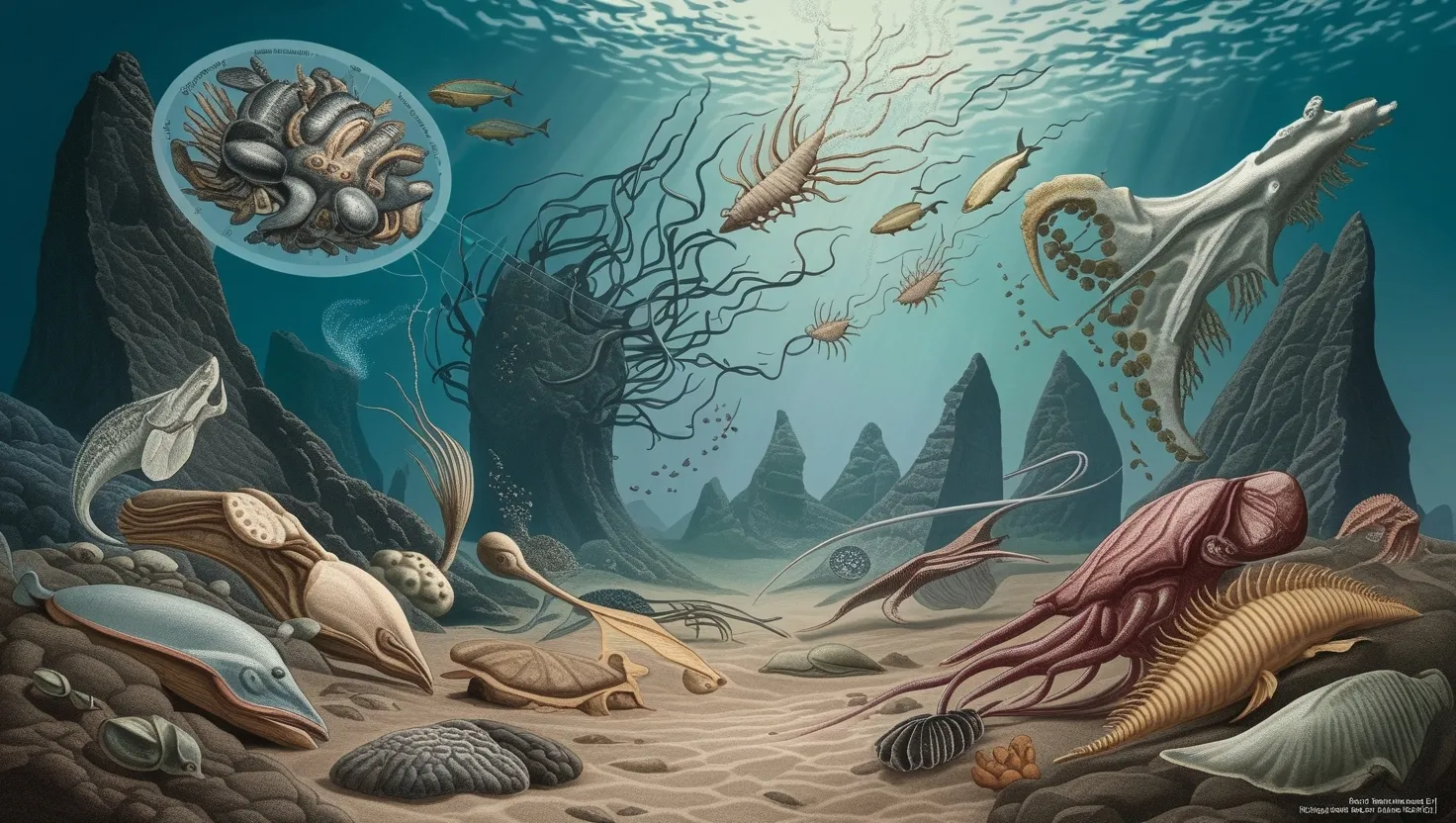The Cambrian period, a pivotal moment in Earth’s history, continues to perplex scientists and challenge our understanding of evolution. Recent genomic analysis of 500-million-year-old fossil specimens has unveiled a Pandora’s box of genetic mysteries that defy conventional wisdom. As I delve into this fascinating topic, I find myself questioning everything I thought I knew about the origins of complex life on our planet.
Imagine, if you will, peering into the genetic code of ancient organisms and finding sequences that look eerily familiar - not just similar to modern life, but bearing the hallmarks of advanced genetic engineering techniques we’ve only recently developed. It’s like stumbling upon a smartphone in a Neanderthal cave. How do we even begin to explain such an anachronism?
The Cambrian explosion has long been a thorn in the side of evolutionary biologists. In the blink of an eye, geologically speaking, life on Earth went from simple, single-celled organisms to a dizzying array of complex body plans. It’s as if someone pressed fast-forward on evolution. But now, with these new genetic findings, we’re faced with an even more perplexing scenario.
“What if the universe is not only stranger than we imagine, but stranger than we can imagine?” - J.B.S. Haldane
This quote from the renowned British geneticist seems particularly apt as we grapple with the implications of these discoveries. The genetic “cassettes” found in unrelated Cambrian organisms are not just similar - they’re identical. It’s like finding the same paragraph in two completely different books. How does that happen by chance?
And it’s not just the shared sequences that are raising eyebrows. The mathematical patterns within these genetic elements follow non-random distributions. It’s as if they were designed rather than evolved. But designed by whom? And for what purpose?
Perhaps even more mind-boggling is the presence of genes coding for proteins that shouldn’t have existed for millions of years after the Cambrian period. It’s like finding blueprints for a jet engine in Leonardo da Vinci’s notebook. These advanced genetic elements appear fully formed, without any of the intermediate steps we’d expect to see in a gradual evolutionary process.
So, what are we to make of all this? Some researchers are proposing radical theories. Could these genetic anomalies be evidence of directed panspermia - the deliberate seeding of Earth with engineered organisms by an advanced alien civilization? It sounds like science fiction, but then again, so did the idea of editing genes with CRISPR just a few decades ago.
Others suggest that these findings point to previously unknown evolutionary mechanisms that fundamentally challenge Darwinian theory. Could there be aspects of evolution that we’ve completely overlooked? What if life has more tricks up its sleeve than we ever imagined?
“The most exciting phrase to hear in science, the one that heralds new discoveries, is not ‘Eureka!’ but ‘That’s funny…‘” - Isaac Asimov
This sentiment certainly applies here. These genetic anomalies are definitely “funny” in the scientific sense, and they’re forcing us to reevaluate our assumptions about the history of life on Earth.
Of course, the scientific establishment is largely dismissing these findings. They attribute them to contamination or misinterpretation of the data. And it’s true that extraordinary claims require extraordinary evidence. But as genetic sequencing technology advances, the precision and consistency of these anomalies are becoming harder to ignore.
What if we’re witnessing the birth of a new paradigm in evolutionary biology? How might this change our understanding of life’s potential, both on Earth and beyond?
It’s worth noting that this isn’t the first time the Cambrian period has thrown us for a loop. The sudden appearance of complex body plans in the fossil record was once seen as a major challenge to Darwin’s theory of gradual evolution. But over time, we’ve developed explanations that fit within the framework of natural selection.
Could these new genetic findings be similarly incorporated into our understanding of evolution? Or are they truly irreconcilable with current theory?
One intriguing possibility is that these genetic “cassettes” represent some form of horizontal gene transfer on a massive scale. We know that bacteria can share genes, even between distantly related species. Could there have been a mechanism in the Cambrian period that allowed for widespread sharing of genetic information between multicellular organisms?
This idea is speculative, to be sure, but it’s the kind of out-of-the-box thinking that might be necessary to explain these puzzling findings.
“The important thing is not to stop questioning. Curiosity has its own reason for existing.” - Albert Einstein
As we continue to probe the genetic secrets of the Cambrian period, we must keep Einstein’s words in mind. The questions raised by these discoveries are profound, and they deserve our curiosity and our rigorous investigation.
What if the Cambrian explosion wasn’t just a period of rapid evolution, but a moment of intentional genetic experimentation? Could an advanced civilization - whether alien or from Earth’s distant past - have used our planet as a laboratory?
It’s a mind-bending concept, but one that we can’t dismiss out of hand. After all, if we had the technology to seed a distant planet with life, wouldn’t we be tempted to try different genetic combinations to see what works best?
Of course, this raises ethical questions. If we’re the result of such an experiment, what does that mean for our place in the universe? And if we’re not, but we develop the ability to do this ourselves, should we?
These are the kinds of philosophical quandaries that arise when we start pulling at the threads of our evolutionary tapestry. Each new discovery has the potential to unravel our understanding and force us to weave a new narrative.
But perhaps the most exciting aspect of all this is the potential for new avenues of research. If these genetic anomalies are real, they could point the way to undiscovered mechanisms of evolution. They might even provide insights that could revolutionize genetic engineering and synthetic biology.
Imagine if we could harness the power of whatever process created these precise genetic insertions. We might be able to engineer organisms with unprecedented speed and accuracy, potentially solving some of our most pressing environmental and medical challenges.
Of course, such power would come with enormous responsibility. The ethical implications of this kind of genetic manipulation are staggering. How do we ensure that such technology, if it exists, is used wisely and for the benefit of all life on Earth?
As we stand on the brink of potentially paradigm-shifting discoveries, it’s crucial that we approach these findings with both open-mindedness and skepticism. We must be willing to challenge our assumptions and follow the evidence where it leads, even if it takes us to uncomfortable or unfamiliar territory.
At the same time, we need to maintain rigorous scientific standards. Extraordinary claims do indeed require extraordinary evidence, and we must be careful not to let our imaginations run too far ahead of the data.
“In the fields of observation chance favors only the prepared mind.” - Louis Pasteur
Pasteur’s words remind us that groundbreaking discoveries often come to those who are ready to see them. As we continue to investigate the genetic mysteries of the Cambrian period, we must prepare our minds to recognize the significance of what we find, even if it doesn’t fit neatly into our current understanding.
What new wonders might we uncover as we delve deeper into the genetic code of Earth’s ancient life? What secrets lie hidden in the DNA of long-extinct creatures, waiting for us to decipher them?
The Cambrian genome project, with all its anomalies and unanswered questions, represents a frontier of scientific exploration as exciting as any in history. It challenges us to think bigger, to question our assumptions, and to imagine possibilities beyond our current comprehension.
As we stand at this crossroads of discovery, peering into the genetic past for clues about life’s origins and potential, we must remember that every great scientific advance began with a question that couldn’t be answered by existing theories.
Whether these Cambrian genetic anomalies represent evidence of ancient manipulation, unknown evolutionary processes, or something we haven’t even conceived of yet, one thing is certain: they are pushing us to expand our understanding of life’s complexity and potential.
In the end, isn’t that what science is all about? Pushing boundaries, challenging assumptions, and constantly seeking new knowledge? As we continue to unravel the mysteries of the Cambrian genome, we’re not just learning about our past - we’re opening up new possibilities for our future.
What wonders might we discover next? And how will they change our understanding of life, evolution, and our place in the cosmos? Only time, and further research, will tell. But one thing’s for sure - the journey of discovery is far from over. In fact, it may have only just begun.






